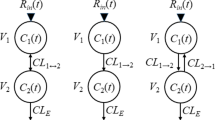Abstract
The literature growth in pharmacokinetics and bioavailability between the years 1964 and 1980 is analyzed. During much of this period, the literature doubled approximately every 1.6 years. However, during the period 1978–1980, little or no growth was observed. During the period 1950–1967, the total chemical literature increased exponentially with a half-life of 8.28 years; between 1968 and 1980, the half-life was 12.4 years. Thus, the pharmacokinetic literature increased at a much more rapid pace than did the total chemical literature in general. The subject of growth is considered in a general context, particularly as influenced by psychological, sociological, political, and economic factors. It is concluded that while mathematical functions may adequately describe past literature trends, they have little if any utility in predicting future trends in specific research areas such as pharmacokinetics.
Similar content being viewed by others
References
J. G. Wagner. History of pharmacokinetics.Pharmacol. Ther. 12: 537–562 (1981).
A. Buchanan. Physiological effects of the inhalation of ether.London Med. Gaz. 39:715–717 (1847).
R. A. Butler. Pharmacokinetics of halothane and ether.Br. J. Anesth. 36:193–199 (1964).
E. Borek. The loneliness of the original investigator.Nature 264:100 (1976).
E. Garfield. Current comments.Current Contents (Life Sciences),No. 43, Oct. 26, 1981, pp. 5–12.
J. Lentine, Managing Editor of International Pharmaceutical Abstracts, personal communication.
D. R. Tousignaut, Editor of International Pharmaceutical Abstracts, personal communication.
R. Mehnert, of the National Library of Medicine (Publisher of Index Medicus), personal communication.
G. O. Platau, Senior Assistant, editorial operations of Chemical Abstracts Service, personal communication.
D. B. Baker. Recent trends in chemical literature growth.Chem. Eng. News, June 1, 1981, pp. 29–34.
CAS Today: Facts and Figures about Chemical Abstracts Service, a brochure published in 1980 by Chemical Abstracts Service, a division of the American Chemical Society, Columbus, Ohio.
J. G. Wagner.Biopharmaceutics and Relevant Pharmacokinetics. Drug Intelligence Publications, Hamilton, Ill., 1971, 1st ed., p. 2.
L. von Bertalanffy.General System Theory: Foundations, Development, Applications, rev. ed., George Braziller, New York, 1968, p. 103.
M. Haire. Biological models and empirical histories of the growth of organizations. In M. Haire (ed.),Modern Organization Theory, John Wiley & Sons, New York, 1959, chap. 10, pp. 272–306.
J. G. Wagner. Relations between drug concentration and response.J. Mond. Pharm. 4: 279–310 (1971).
K. E. Boulding. Toward a general theory of growth.General Systems 1:66–75 (1956).
Author information
Authors and Affiliations
Rights and permissions
About this article
Cite this article
Boxenbaum, H. Literature growth in pharmacokinetics. Journal of Pharmacokinetics and Biopharmaceutics 10, 335–348 (1982). https://doi.org/10.1007/BF01059265
Received:
Revised:
Published:
Issue Date:
DOI: https://doi.org/10.1007/BF01059265




